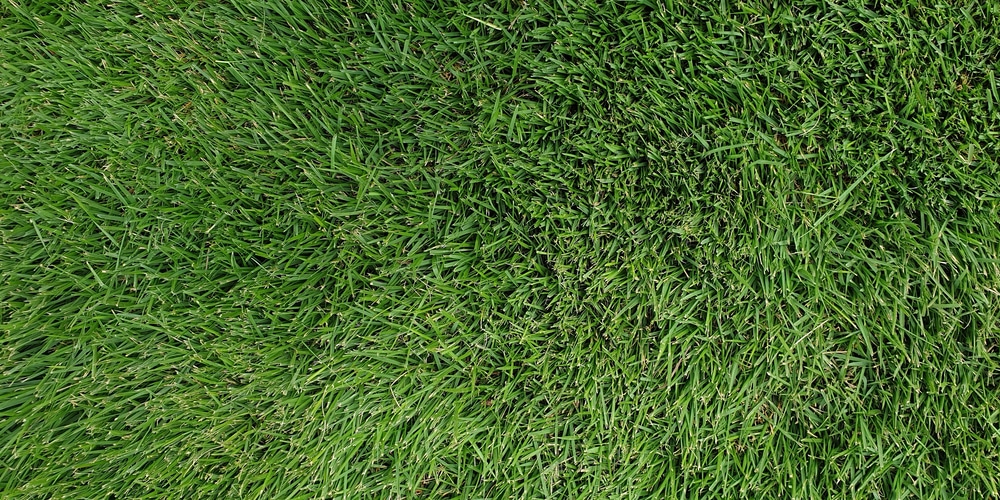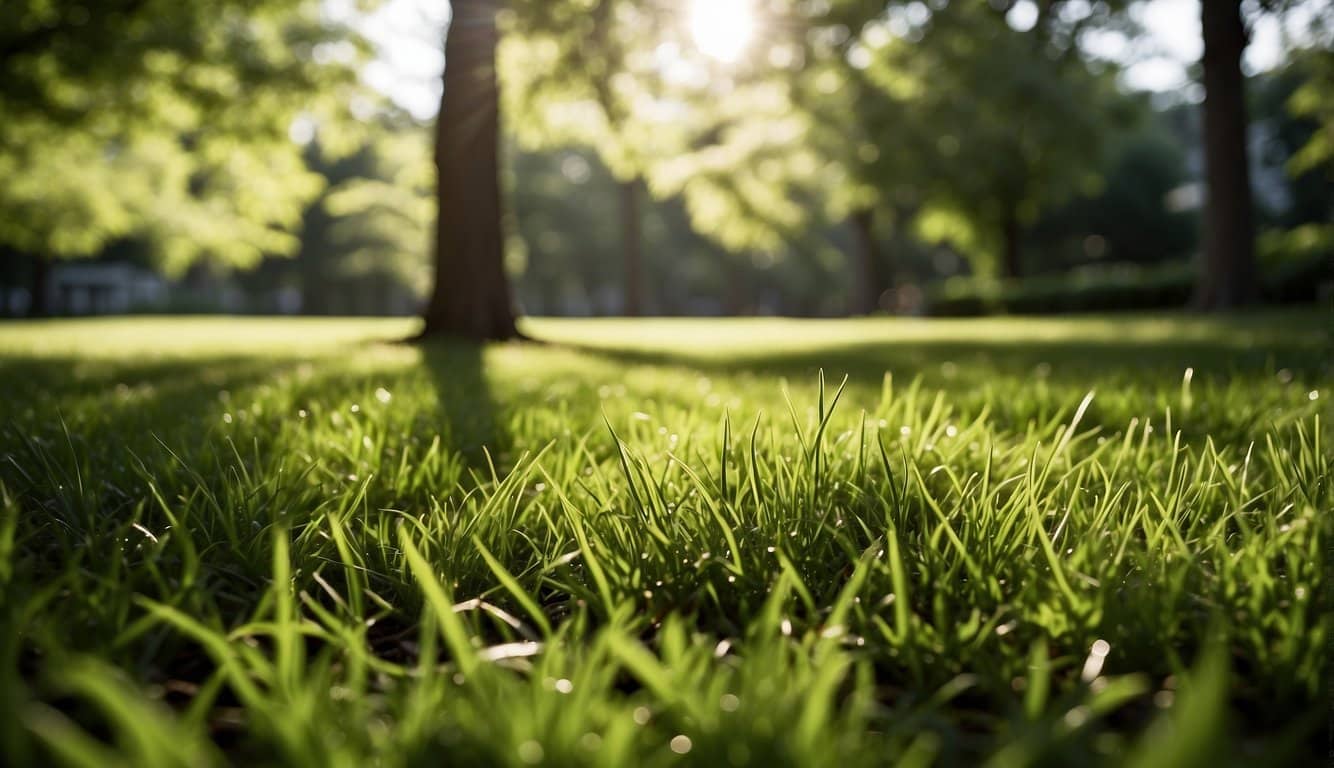Grass Seed Mixes
Selecting the right grass seed mix is essential for a lush, durable lawn that can thrive in varying conditions of sun and shade. Here’s what you should know about grass seed mixes:
- Sun & Shade Mixes: These blends are specifically formulated to provide a resilient turf that can prosper in both sunny areas and under the canopy of trees.
- For example, Scotts Turf Builder Grass Seed Sun & Shade Mix is designed to establish deep roots and build a strong, green lawn suitable for a range of lighting conditions.
- Adaptability: Quality mixes contain different types of grasses, such as Kentucky Bluegrass, Perennial Ryegrass, and Fine Fescue, each chosen for their adaptability and growth patterns.
- Nature’s Seed offers a Sun and Shade Grass Seed Mix that incorporates several varieties to balance the contrasting growth environments.
- Shade Tolerance: Certain grass species, like the ones found in Pennington Smart Seed Dense Shade Grass Mix, are adept at growing in lower light, making them a smart choice for heavily shaded lawns.
- Soil pH Importance: For the best results, note that most grass mixes, including those for sun-and-shade, prefer a soil pH between 5.5 and 7.0.
- Soil testing every few years can help maintain soil health for optimal growth.
When choosing a mix, consider:
- Your lawn’s specific sun and shade pattern
- The foot traffic and use of your lawn
- Your local climate and growing conditions
Shade Tolerant Grass Species
When selecting grass seed for shady areas in your yard, it’s crucial to choose species that have a higher tolerance for low-light conditions. Whether your garden falls into the cool-season or warm-season climate zone will determine which grasses will thrive beneath the shade of trees and buildings.
Cool-Season Shade Grasses
- Fine Fescue: Thrives in dry shade; fine texture and deep green color.
- Tall Fescue: Prefers moderate shade; drought-resistant with coarse blades.
These cool-season grasses are known for their ability to survive in areas with less sunlight, and they often require less maintenance than their sun-loving counterparts.
Warm-Season Shade Grasses
- St. Augustine: Known for exceptional shade tolerance and thick carpet-like sod.
- Zoysia: Forms a dense turf, tolerates partial shade, and offers high disease resistance.
Each of these warm-season grasses can provide a robust solution for your shaded lawns. Their ability to persevere in shaded areas accompanied by their unique qualities make them suitable choices for a lusher lawn even with limited sunlight exposure.
Sun-Loving Grass Varieties

Before diving into the specifics of grass that thrives in sunlight, it’s important to know your chosen mix should be robust and adaptable to bright conditions.
Transition Zone Challenges
- Climate Considerations: You’re in a unique situation in the Transition Zone as the climate can swing hot and cold.
- Grass Selection: Here are some of your best bets for sun-loving grasses in these conditions:
- Zoysia Grass: Adapts well from bright sun to partial shade—remarkable for its tolerance to both heat and moderate cold. It can be found in options such as lawn grass seed from American Meadows.
- Tall Fescue: Deep roots make it sturdy under the sun, although it appreciates a drink more frequently in peak summer.
- Bermuda Grass: It loves the heat and stays robust even in the high noon blaze.
By selecting these varieties, you’ll equip your lawn to handle the sun’s full attention with grace.
Mixing Strategies for Shade and Sun
Creating a lush, green lawn requires selecting the right grass seed mix that can thrive in both sunny and shaded areas of your yard. Your choice of seeds must take into account the different light conditions to ensure uniform growth. Here are some strategies to help you find the balance:
- Evaluate Your Lawn’s Light Conditions: Determine how many hours of sunlight and shade your lawn receives. Note that different areas may have varying conditions.
- Full Sun: More than 6 hours of direct sun daily.
- Partial Shade: 4 to 6 hours of sun, preferably in the morning.
- Dense Shade: Less than 4 hours of sun or filtered light.
- Choose a Balanced Seed Mix: Opt for a grass seed mix that offers a range of varieties suitable for both conditions. Look for terms like “sun and shade” in product names.For instance, Hancock’s Sun & Shade Lawn Seed Mix is tailored for varying light conditions.
- Seed Varieties for Optimal Growth:
- For Sun: Consider Kentucky Bluegrass, known for its durability.
- A seed mix predominant in Kentucky Bluegrass can withstand sunny conditions.
- For Shade: Fine Fescue varieties are shade tolerant and require less sunlight.
- Seeding Rates and Maintenance:
- Seeding Rate: Higher rates in shaded areas to compensate for lower germination rates.
- Maintenance: Shaded grass may require less water but ensure the soil isn’t compacted to promote root growth.
- Products like Scotts Turf Builder Grass Seed Sun & Shade Mix can assist with nutrition and soil improvement.
Maintenance Practices for Balanced Growth
When caring for lawns with both shady and sunny areas, balanced growth is crucial. Your goal is to maintain a lush, even lawn regardless of light levels. Here’s how you can achieve that balance:
Soil Conditions:
- Test your lawn’s soil pH to ensure it falls between 5.5 and 7.0, as this range supports optimal grass growth for most species in varied light conditions.
- For low pH levels, apply lime to your soil to restore balance and improve nutrient availability.
Watering Regimen:
- Maintain moisture for new grass seed by watering once or twice daily until growth is sufficiently established.
- Afterward, shift to a normal watering schedule, keeping in mind that shaded areas may require less water due to reduced evaporation.
- Cut grass at the top of the recommended height to encourage deep rooting and maximum leaf area for photosynthesis, especially in shaded areas.
- Sharpen your mower blades to ensure clean cuts and minimize stress to the grass.
Fertilization Techniques:
- Apply fertilizer at a lighter rate in shaded areas compared to sunny areas to prevent overstimulation of growth where light is limited.
- Opt for a slow-release fertilizer that provides a steady supply of nutrients.
Choosing the Right Seed:
- Select a grass seed mix that is specifically designed for both sun and shade, such as Scotts Turf Builder Grass Seed Sun & Shade Mix, to ensure even growth across your lawn’s varied conditions.
Frequently Asked Questions
Selecting the right grass seed mix is crucial for a lawn that faces varying levels of sunlight and shade. These FAQs aim to shed light on the nuances of using sun and shade mixtures.
What are the best conditions for growing grass from sun and shade mixes?
For grass seeds from sun and shade mixes to thrive, your lawn should have a balance of 4 to 6 hours of sunlight daily and moderate shade. Moreover, ideal soil conditions, including a pH between 5.5 and 7.0, promote better growth.
How do sun and shade grass seed mixes differ from full sun or dense shade seed mixes?
Sun and shade grass seed mixes are specially formulated to perform well under fluctuating light conditions. In contrast, full sun mixes require extensive sunlight throughout the day, whereas dense shade mixes are adapted for low-light areas.
Can you use the same type of grass seed for both shaded and sun-exposed areas of a lawn?
Yes, you can use a sun and shade grass seed mix for your entire lawn. These mixes contain grass varieties like Kentucky Bluegrass that are versatile and can adapt to different light conditions.
What are the primary types of grass seeds contained in sun and shade mixes?
Typical sun and shade mixes include resilient grass types like Kentucky Bluegrass, Fescues, and Ryegrass. Each of these brings unique characteristics that help the lawn stay robust whether it’s sun-drenched or shaded.
How does the performance of grass seed mixes specifically designed for both sun and shade compare to single-purpose grass seed?
Grass seed mixes for sun and shade offer versatility; they’re engineered to provide consistent coverage and vitality across different lawn areas. Single-purpose mixes, however, may falter outside their recommended light exposure levels.
How should you adjust lawn spreader settings when sowing a sun and shade grass seed mix?
The settings for your lawn spreader will vary depending on the recommended overseeding and new lawn coverage rates found on the grass seed package.
For instance, the overseeding coverage might be the higher number to use if you are interspersing seeds into an existing lawn.
Last update on 2024-07-26 / Affiliate links / Images from Amazon Product Advertising API



